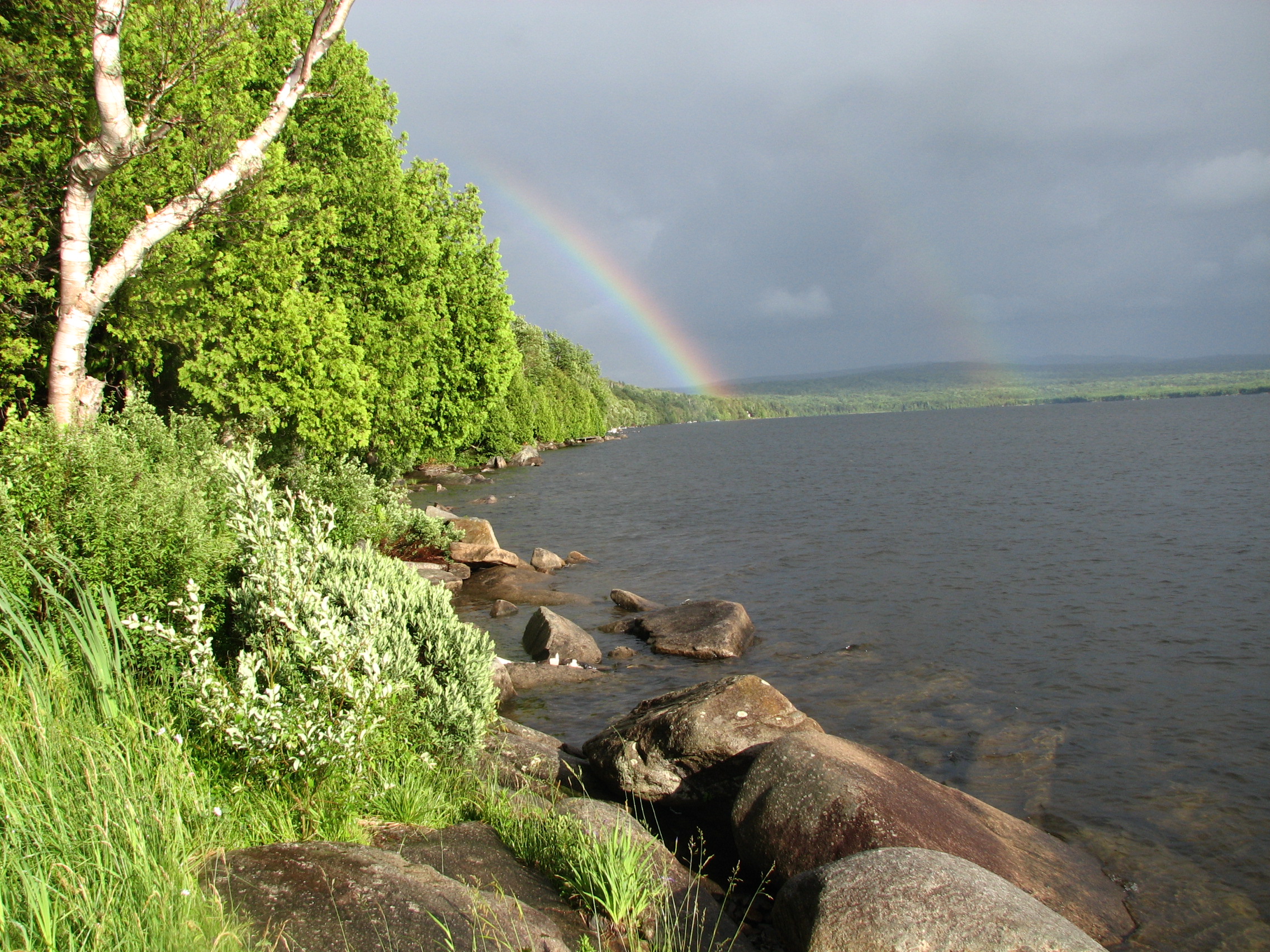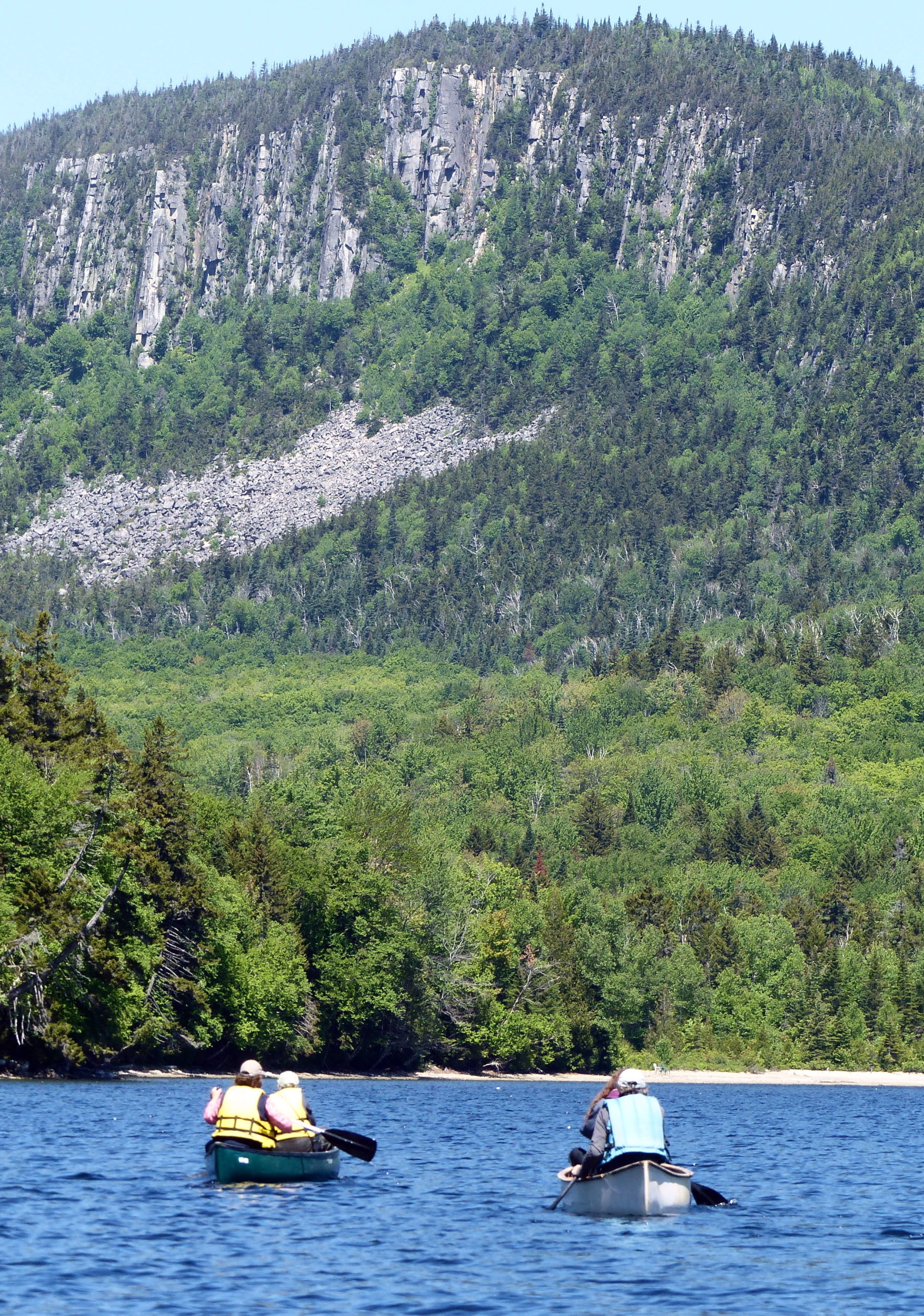
Sunrise in northern New Hampshire. © Eric Hanson
It’s June 15, the night before my VCE Mountain Birdwatch (MBW) route, and a week away from the summer solstice. I’m trying to go to sleep at 7:30 p.m. Not easy. I had spent the day surveying Vermont lakes for loon pair activity on my way east and north (Stiles Pond, Miles Pond, Neal Pond, Maidstone Lake, and West Mountain Pond). Now, I’m camping out between the Second and Third Connecticut Lakes in what feels like the end of civilization in far northern New Hampshire. What’s crazy is that if I could cross the nearby Canadian border (not possible since border crossings are prohibited due to COVID-19), I’d descend upon southern Canadian lands of farm fields and eventually Quebec City–a very civilized landscape.
My MBW route, called Prospect Hill, is literally the international border swath. They recently cut back the vegetation along the swath, making for much easier walking these past two years compared to the previous seven years, which entailed bushwhacking and stumbling for a mile plus in knee- to waist-high scrub. By “they” I mean those people who clear the 50-foot wide swath along the border between the U.S. and Canada from the Atlantic to the Pacific oceans. Who are they? I’ll sign up for the Montana stretch, but not New England. For my MBW route, I actually follow a trail maintained by The Nature Conservancy for the first mile that leads to the Fourth Connecticut Lake, the true headwaters of the 406-mile Connecticut River.
Like most nights before MBW, my sleep is fitful. A Barred Owl chimes in between 1 and 2 a.m. The alarm goes off at 3:25 a.m. I usually camp in a New Hampshire state campground, but due to the coronavirus, it’s not open. In my third year of doing this route I found a camping spot off a state forest road/snowmobile trail to avoid paying $23 for a pit toilet and the usual six- to seven-hour stay. From my secret spot, it’s a 10-minute drive to a scene from a James Bond movie high in the Alps. A huge, enormous (redundant, I know, but it needs to be) building wrapped by a 10-foot high fence with barbed wire sits at the height of land with mountain ridges (really just big hills) on either side. It’s the U.S. Customs and Border Protection Station. It’s all lit up like Times Square–I’m serious. If the manicured lawn was just a bit bigger, you could hold a Friday night high school football game under the lights here. It’s a post 9/11 structure which I’m sure cost millions for the ~175 cars that cross at this spot each week (and that was pre-COVID-19). I think it receives more snowmobile traffic in the winter than cars in the summer. There’s actually a sign that says “All snowmobiles must come to complete stop for inspection.”
I park at the designated area near the guard station, and thirty minutes (and nearly 1,000 feet in elevation gain) later, I reach the first point of my MBW route at 4:15 a.m. I pull out my data sheets and start prepping my mind for bird call reception. I’m not nearly as good at this as finding a loon nest, but I try. My faithful Blackpoll Warbler is whispering his delicate trill in about the same spot to the SW as he has for the past five years. Swainson’s Thrush call from, I think, every direction. I wish one in particular would quiet down for a few minutes so I could hear beyond him. I hear White-throated Sparrows, Yellow-bellied Flycatchers, a Winter Wren. I continue on my route. Ultimately, I did not have any Hermit Thrushes, which I’ve had in the past, nor Bicknell’s Thrush, which I’ve heard only once in nine years on this route. This time, I think I heard more blackpolls than in any other year and I recorded my first Boreal Chickadee. I love these birds with their emphatic Chicka-DEE-DEE! I would not want to extricate one of these feisty birds out of a mist net knowing how Black-capped Chickadees will try to peck your knuckles off. They mean business with a call like that.
It’s calm and sunny and the temperature has risen from the mid-40s to the upper 50s by the time I finish my route and head back down to my truck. I dine for breakfast on the shores of the Second Connecticut Lake with fresh coffee (1.5 liters worth), and my Grapenuts with walnuts, cranberries, and powdered milk. I drive south past First Connecticut Lake and Lake Francis, following the Connecticut River to Stewartstown and Canaan, where I take the right into Vermont to visit the Averill Lakes (after a quick survey of Lake Wallace on the border). Great Averill is like glass. This lake is rarely calm, so it’s a good day to paddle and survey the entire lake. There are two established loon pairs on the lake and we suspect there might be a third pair forming based on observations from our VCE trip there a year ago June, where we spent three days at Quimby Country resort (we hope to run another three-day trip in 2021 at this classic lakeside resort–stay tuned).

A stunning double rainbow and typical wind-driven chop on Great Averill Lake in 2010. Conditions were unusually clear and calm during my visit this past June. © Eric Hanson
Paddling down the northeast shoreline to the rocky outcrops at Quimby’s in the south end, I do not see any loons. Because it’s so quiet, I can hear a cooing noise from across the lake–my favorite loon call. I discover that it’s the new third pair courting and maybe even nest-site searching. I head to the southwest inlet nesting raft site where, two weeks earlier, a volunteer witnessed a major loon fight. Two adults had each others’ necks in their bills and were boxing each other with their wings. They submerged, and stayed under for what seemed like a very long time before they surfaced. One of them (the loser) wing-rowed all the way across the lake to get away. I wonder if this could have been a territorial boundary dispute with the new south pair and now the lines are drawn? The volunteer also found a loon egg on the beach about 30 meters from the raft. Could an eagle have carried the egg out of the nest? I find a solo loon hanging out in the cove. Its mate is a quarter mile north making his/her way back. I head to the raft to see what’s happening, and find a cold egg that’s been there since the pair abandoned the nest. I collect it for mercury analysis and head back north. Near the outlet in a shallow cove, I spot a loon incubating on the “north” raft. Over the ensuing weeks, I learned that the southwest pair re-nested, but the eggs were depredated again. The north pair abandoned the nest for unknown reasons.

Paddlers on Little Averill Lake take in the view of Brousseau Mountain during VCE’s loon and songbird event in 2018. © Eric Hanson
I load the canoe onto my truck and head for Little Averill Lake, were there are two known territorial loon pairs. On the water, I only see one adult in the north end, and it follows me to the nesting raft. I find fresh signs of nest building, so there is a chance these two will have a late nest. I keep paddling… Over on the west end, below the cliffs of Brousseau Mountain, I come across a sentry loon right out in front of the inlet where the raft is located. He/she sits there motionless. I see its mate on the raft and watch it slide off into the water. I wait for a possible nest exchange, but it never occurs. The one bird still floats quietly, and the other swims out into the open lake. I check the raft to find it covered in goose droppings. There are several rafts where we place “goose guards” to keep geese from nesting. We remove the guards by mid-May, when most geese have found nest sites and loons are starting to search for theirs. Geese did not nest here after I removed the goose guard in May, but they sure used it as a perch site. I use my paddle to scrape off the mess, and go to shore to collect fresh mud and vegetation to cover the nest bowl area. I later learn this loon pair was nesting by June 26th and had one chick the day after Loonwatch Day, July 18. The north pair nested shortly after my visit and hatched two chicks.
I make a few more short stops on the way home, checking Derby Pond and Clyde Reservoir–and find no nesting activity on either pond. Spending two consecutive days conducting loon surveys with an early morning songbird survey in the middle makes time do funny things; but not in a bad way. Events blur together a bit and I almost forgot that 14 hours earlier I was on a boreal ridge looking out toward the St. Lawrence River Valley, and 30 hours earlier I was starting out on this mini-adventure. Needless to say, this annual ritual has become a highlight of my field season.
(If adventures like this sound like fun to you, join us! Visit the Mountain Birdwatch or Vermont Loon Conservation Project pages on the VCE website to learn how you can get involved.)

a great round!!!
but a young person’s game….
thanks, PAUL